skip to main |
skip to sidebar
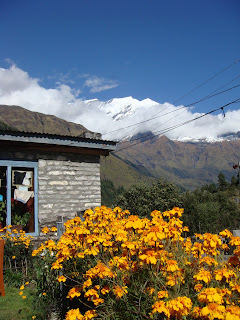 The next segment of my trek around Annapurna dropped down into the Kali Gandaki river canyon which is reportedly the deepest canyon in the world. This is due to the fact that Annapurna lies on one side of the canyon and Dhaulagiri on the other; both are 8,000 meter peaks. I had heard or read about the awesome depth of this canyon prior to doing the hike so I hiked down into the canyon expecting some sort of record-breaking grandiosity. Instead I found something in between the cool stuff I saw both before and after; an airport, a road, and a vacation from trekkers.
The next segment of my trek around Annapurna dropped down into the Kali Gandaki river canyon which is reportedly the deepest canyon in the world. This is due to the fact that Annapurna lies on one side of the canyon and Dhaulagiri on the other; both are 8,000 meter peaks. I had heard or read about the awesome depth of this canyon prior to doing the hike so I hiked down into the canyon expecting some sort of record-breaking grandiosity. Instead I found something in between the cool stuff I saw both before and after; an airport, a road, and a vacation from trekkers.

Now when looking back I realize that this segment of the trek from Muktinath to Tatopani has changed from what it once was and probably could never have lived up to my expectations. Now it is somewhere between a trek and a jeep excursion. The wealth is somewhere between third world and developing. And the mountains on the sides of the canyon are just a bit too far apart for me to feel like it truly is the deepest canyon in the world.

The canyon was still spectacular notably for the width of it's free-flowing river and floodplain, the shear size of it's landslides, and it's history. I don't believe I have ever seen such a large un-dammed river. The floodplain for the river was at least 1/2 mile wide and it was easy to see since no one in Nepal is dumb enough to build in the gravelly floodplain. At home of course, people always seem to build in floodplains, but the land has been so modified that identifying the floodplain can be difficult.
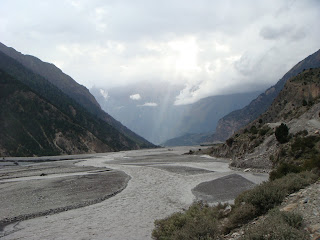
One related side-effect of such a free-flowing river is landslides. I saw several very large landslides as I walked down the canyon, some which may have been initiated by river channeling and some which appeared to be primarily a function of the relative youth of the Himalaya. It is these very landslides which seem to be the only thing which is holding up the advance of roads. From Muktinath to Tatopani there was a two-wheel jeep track / road but it was far from being a thru-road since I saw a few impassable sections where huge landslides had taken out the road.

Even though the road does not go thru I was surprised at how many tourist/trekkers I saw who took up positions inside the ubiquitous Land Rovers. Below Jomsom, where there is a small airport, I saw almost no hiking trekkers. It seems many of my previous trail compatriots from before the Thorung La either escaped the wilderness via the airport or gave up on hoofing it down canyon.

Although the jeep road/trail left a very noticeable scar along the side of the canyon it was still easy to see how cool the Kali Gandaki canyon was before the road. People have been travelling through this canyon for centuries. I understand that for many centuries this canyon was the locus of the salt trade between Tibet and Nepal. Food, including grains grown in the lower portions of the Kali Gandaki, were traded with the Tibetans who harvested salt on the high plains.

The Thakalis who live in this area have built up some good, clean and well-run guesthouses. I was particularly impressed by The High Plains Inn in Tukche. Another treat was the always available apple pastries. There is a significant apple industry near the town of Chame and every eating establishment seems to offer great apple pie or apple crisp.
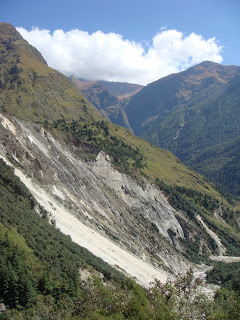
I ended this segment of the trip staying overnight in Tatopani, ate a great Mexican meal, and took a dip in the famous Tatopani hot springs. Then I started hiking back uphill . . .

 If the title makes no sense, then I guess you haven't experienced the Nepali karmic solution to dangerous driving conditions.
If the title makes no sense, then I guess you haven't experienced the Nepali karmic solution to dangerous driving conditions.

I just returned from my vacation to Nepal, Korea and Thailand last week and this is just one of the life lessons I learned while traveling in Nepal. I am still not sure if I have really figured out Nepal yet, but I had an absolutely amazing once-in-lifetime (but hopefully to be repeated) experience trekking near Annapurna. For this post I will just tell you a little bit about Nepal, since I could probably write a book each about the time I spent in Thailand and Korea. I am not even going to try a full travelogue since the three weeks spent in Nepal truly felt more like a 6-month odyssey. At least to me!

First of all, let me explain the title. On several occasions I had the pleasure of traveling on the narrow potholed and winding mountain roads which are the main vehicle highways in Nepal. One thing is certain, these road-trips were the most dangerous aspect of my entire solo hiking trip! Standard procedure whether in a 80's era taxi sedan, vintage Indian bus, or lumbering Tata freight truck, is to honk your horn repeatedly when passing another vehicle on the wrong side of the road (in the opposing traffic lane). Honking is of course used for all sorts of other reasons, but it is done with such singular and life-affirming purpose when passing a lumbering vehicle on an absolutely blind mountain corner that I became convinced that the horn is the #1 traffic safety device in Nepal. It appears, that whether or not the horn can be heard by the oncoming traffic makes no difference. Honking the horn relieves the driver of his responsibility to make sure that no one is coming. And since it seems there is rarely a pocket of road where safe passage around a slow vehicle can be visually verified the logic is to honk the horn and have trust in your karmic fate.

My taxi driver who drove me 5 hours to the beginning of the trek was kind enough to point out three blind-corner fatal car wrecks within the first 30 kms or so of our drive. He assured me that he felt getting to the destination alive was more important than speed, but I wonder a bit about how truthful he was being. He laughed when he showed me how his horn was only working intermittently!

Since I arrived in Kathmandu just before the beginning of Dashain (a big holiday) I had the choice of waiting several days to start my trek or hiring a taxi on the last day before travel was restricted. I hired a taxi to drive me to my starting point on the Annapurna trek. And then since half the Indian Ocean was dumping on the Himalayas when I arrived I jumped into a jeep to get to the end of "road". I began hiking from Bhule Bhule at about 5PM on October 6. I made it Ngadi and fell for the hard sell at the first guesthouse. Now I am starting to wish I kept a diary since there is no chance I can remember the guesthouse name. It seems most of the guesthouses have extremely predictable and completely un-original names like Ngadi Guesthouse or Ngadi Riverview Inn. On a sidenote a couple of easily remembered places and favorite stays were at the High Plains Inn in Tukche and Bob Marley Guesthouse in Muktinath.
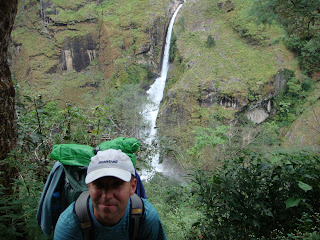
Anyway, I really began to experience the trek when I started hiking on Oct. 7. I knew that the hike was supposed to take me from very modest elevations up to high elevations but I didn't realize until that day that I would actually be hiking through such lush relatively low elevation areas. I was just blown away by the beauty of walking through terraced farming areas. It seemed like I was passing through a small village every 20 or 30 minutes and marveling that these were no tourist villages. Most of the people in many of the small villages appeared to be living there much like their great-great grandparents probably did, living off the land.

The power lines arced overhead along many parts of the trail, but thanks to the lack of a road, the villages were quiet and relatively peaceful places. I was a bit dismayed to see how much garbage, plastic bottles and bags etc., littered the sides of the trail but it was easy to see that the further I got from the roads the less of the garbage I saw. Most of the time there were far more livestock droppings on the trail then garbage (rubbish).

The trail slowly wound up the ever-deepening canyons changing from lush tropical vegetation to more temperate pine forests. It was here in the pine forests between Tal and Chame where I started to feel at home. These forests were similar to many others which I have hiked. They were places were I could imagine deer and bears similar to those at home. The buildings also started to change to being sturdy wooden structures. In the lowlands the buildings seemed to just be mish-mash of whatever building materials were available, including plastic sheeting for walls and corrugated metal roofs. In Chame I stayed in a nice new wood lodge. It may not be nearly so enjoyable in a year or two, but at the time of my stay the all-wood floor, walls and ceiling was so fresh you could still smell the scent of the fresh-cut wood.

Although the forests were a lot like home in this particular area (Chame) the canyons were much deeper and slopes much steeper. Since the monsoon clouds were still stalking me I still could not see the tops of the hillsides, but it was obvious I was still at the bottom of huge mountains. The river at the base of the canyon was just a huge rushing torrent of whitewater. I crossed the river on countless swaying suspension bridges and wondered what life was like before the suspension bridges. Many of the villages would have been entirely cutoff from even the closest village, let alone the outside world, without a bridge. There was no other way to cross these rivers. In many places they are unfordable.

I think on day 4 the clouds cleared and the canyons started to open up into the large Manang valley. I took my friends' (Ana and Keith) advice and walked to Upper Pisang in order to stay in a guesthouse with good views. The accommodations here were a bit more rustic than in Lower Pisang (satellite dishes!) but the view of Annapurna III was incredible. Since I got here early I also took a stroll up the trail toward Pisang Peak base camp in order to acclimatize. The view from my high point was unbelievable! I sat and stared at the Annapurna massif from below flapping prayer flags until my fingers were numb. I also saw some sort of high alpine deer and a whole bunch of yaks grazing on the open slopes below Pisang. The soaring Lammergeiers seemed to be always floating overhead in these high beautiful places. The Lammergeier vultures appear to live such a charmed life, almost never flapping a wing, floating in some of the most beautiful places in the world. I aspire to be reincarnated as a Lammergeier.

After Upper Pisang I followed the upper trail out of Upper Pisang and was treated to fabulous view after fabulous view. This is one area where I regret not taking extra days. Here Tibetan influenced buddhist villages seem to sit on every prominent viewpoint. The buildings at these places are constructed almost entirely of stone. At the time I passed through many of the people were out harvesting grain. I watched them cutting the grain with the ever ubiquitous scythes, laying it out to dry and then tossing it to separate the chaff. If ever there was a shangri-la for me the area around Upper Pisang might just be it.

I stayed at Manang which is basically the last major settlement which is not solely devoted to tourists, prior to the Thorung La, highest pass of the trip. Although Manang is an ancient town and non-tourist oriented life abounds around it, most of the business in town is absolutely geared for the tourists. In fact they were showing movies the predictable movies Vertical Limit and Into Thin Air at a couple of places. There are several large lodges, some good bakeries and a fairly reliable power supply. If I remember correctly, Manang was at about 11,000 feet so many trekkers stay here for a couple of days to acclimatize. I tried to check out a monastery near Manang but it was closed when I visited. So I enjoyed a quiet sit with a couple of yaks on the monastery doorstep.

Personally I got tired of Manang quickly, probably due to the annoying presence of so many tourists. So after one night here I took off with the intention to get as far up toward the Thorung La as reasonable and to snag a good room at one of the few lodges before the pass. It wasn't my intention, but I ended up at the penultimate lodging before the pass at Thorung Phedi (4600m). There is only one higher place called High Camp. Fortunately, I got there just in time to snag one of the last spots in the dormitory.

Thorung Phedi is not a particularly enjoyable place and because I came down with traveller's diarrhea, for me it quickly become a somewhat dreadful place. I survived a terrible night of sickness with little sign of altitude problems, and so the next day I set off to cross the Thorung La, the highest point on the trek (5400m).

My trek to the pass was a bit of an anticlimactic struggle. I was so prepared to be utterly beaten, broken, sick and tired that I was not particularly impressed when I finally made it to the high point 2.5 hours after starting! By no means was it easy. I was sufficiently amazed at how difficult it is to breathe at nearly 18,000 feet, but the actual place didn't excite nearly as much as I had hoped. The place is primarily an iconic photo point for the thousands of trekkers who have paid and grunted their way to this high point. Most of the views of rock, ice and snow are little different than those I have seen elsewhere. There was ice/snow and a small teahouse at the top, but I did little more than take a photo before dropping off the other side of the pass. I was in a bit of a hurry to get away from the growing crowd and to get to warmer and more hospitable terrain.
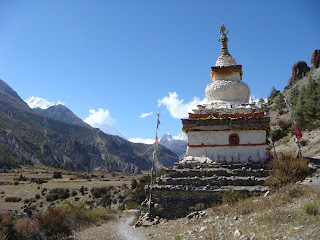
That is enough for now! Tune in again for more unbelievable adventures from Adam's memory.



























